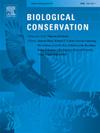Prescribed burning in montane Nardus grasslands: Fire frequency is key to balance vegetation structure and diversity
IF 4.4
1区 环境科学与生态学
Q1 BIODIVERSITY CONSERVATION
引用次数: 0
Abstract
Semi-natural grasslands are increasingly threatened by abandonment and intensification, highlighting the need for effective management tools. Here, prescribed burning (PB) is tested as a cost-effective and easily accessible alternative to animal-bound grassland management for maintaining not only the openness of grassland fallows: Our study investigates the effectiveness of different PB frequencies for the conservation management of montane Nardus grasslands. We experimentally tested the effects of recurrent application of prescribed burning at three different frequencies on diversity, vegetation structure and soil parameters of two Nardus grassland communities (species-poor and species-rich) compared to fallows in the central German Rhön Mountains over 8 years. We showed that PB effectively mitigates negative effects of secondary succession on vegetation structure, mainly by reducing moss cover and litter accumulation. While frequent PB slightly reduces species richness and promotes a few dominant species, less frequent burning (e.g. burning every 3 years) prevents these negative effects. PB had minimal effects on soil parameters of our study sites. Different PB effects on species-rich and species-poor communities, respectively indicate that the initial species composition plays an important role in mediating fire effects. Our findings indicate that late winter/early spring fires at low frequencies can act as appropriate tools for maintaining a favourable conservation state of montane Nardus grasslands, but that the initial species composition has to be carefully considered before application.
山区草原规定燃烧:火灾频率是平衡植被结构和多样性的关键
半天然草地日益受到撂荒和集约化的威胁,因此需要有效的管理工具。本文研究了规定焚烧(PB)作为一种具有成本效益且易于获得的替代方法,不仅可以保持草原休耕地的开放性,还可以作为动物约束草地管理的一种替代方法。在8年的时间里,我们通过实验测试了以三种不同频率重复使用规定燃烧对两种纳尔达斯草原群落(物种贫乏和物种丰富)的多样性、植被结构和土壤参数的影响,并与德国中部Rhön山脉的休耕地进行了比较。研究表明,PB有效缓解了次生演替对植被结构的负面影响,主要是通过减少苔藓覆盖和凋落物积累。频繁的森林焚烧会略微降低物种丰富度,并促进少数优势物种的生长,而较少的森林焚烧(如每3年焚烧一次)可以防止这些负面影响。PB对研究地点土壤参数的影响最小。不同PB对富、贫物种群落的影响不同,表明初始物种组成在调节火灾效应中起重要作用。研究结果表明,低频率的冬末/早春火灾可以作为维持山区纳杜斯草原良好保护状态的适当工具,但在应用前必须仔细考虑初始物种组成。
本文章由计算机程序翻译,如有差异,请以英文原文为准。
求助全文
约1分钟内获得全文
求助全文
来源期刊

Biological Conservation
环境科学-环境科学
CiteScore
10.20
自引率
3.40%
发文量
295
审稿时长
61 days
期刊介绍:
Biological Conservation is an international leading journal in the discipline of conservation biology. The journal publishes articles spanning a diverse range of fields that contribute to the biological, sociological, and economic dimensions of conservation and natural resource management. The primary aim of Biological Conservation is the publication of high-quality papers that advance the science and practice of conservation, or which demonstrate the application of conservation principles for natural resource management and policy. Therefore it will be of interest to a broad international readership.
 求助内容:
求助内容: 应助结果提醒方式:
应助结果提醒方式:


